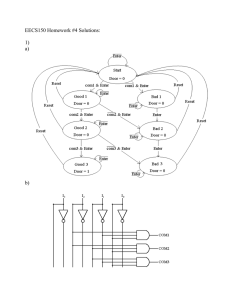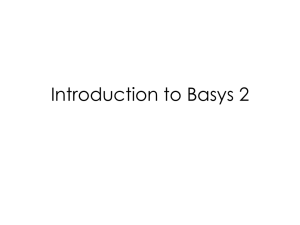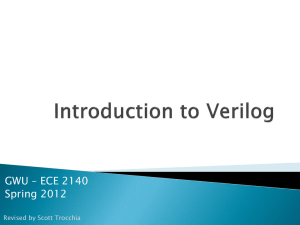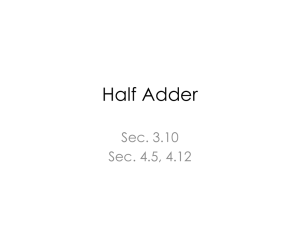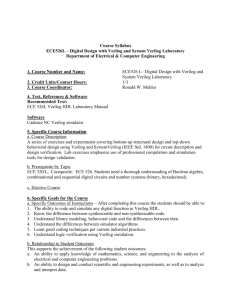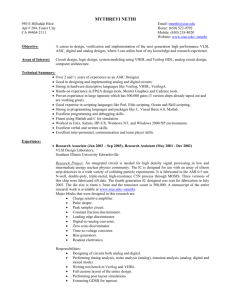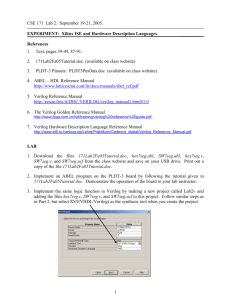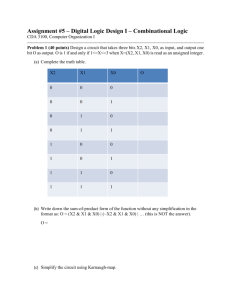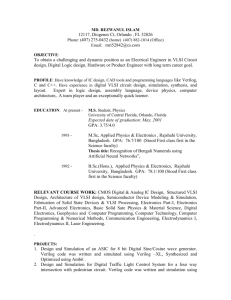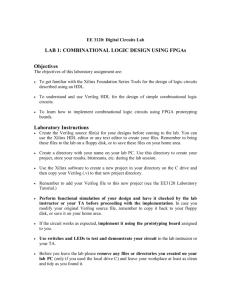Reference1 - IC-Test Lab, NCUE, Taiwan
advertisement
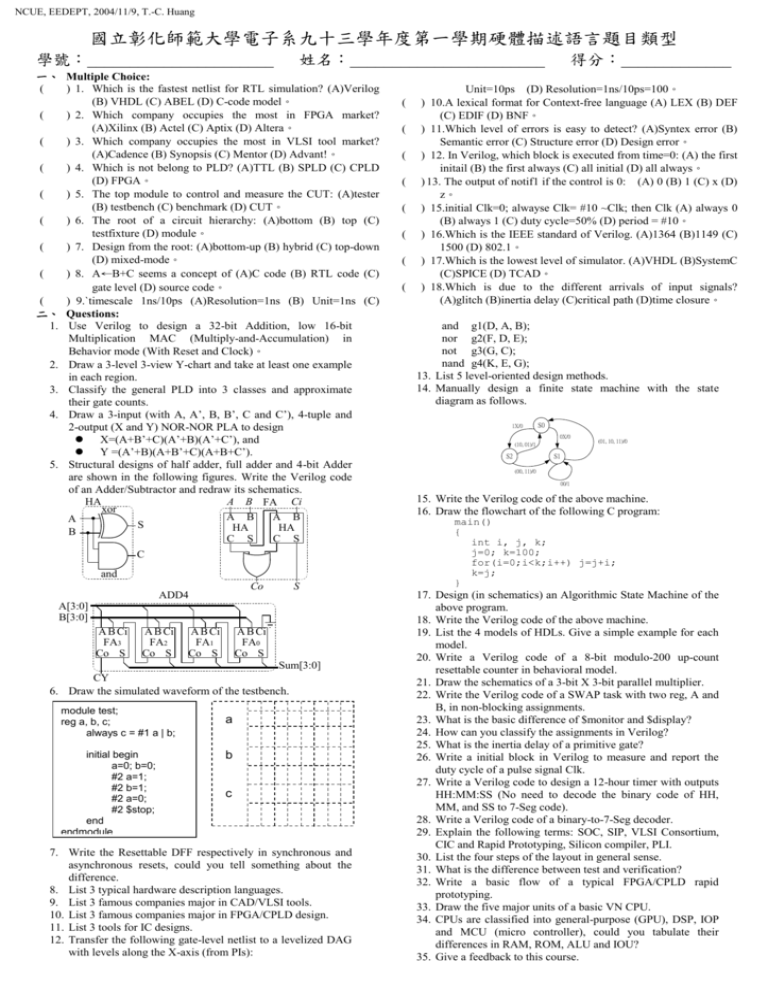
NCUE, EEDEPT, 2004/11/9, T.-C. Huang
國立彰化師範大學電子系九十三學年度第一學期硬體描述語言題目類型
學號:______________________
姓名:_______________________
一、 Multiple Choice:
(
) 1. Which is the fastest netlist for RTL simulation? (A)Verilog
(B) VHDL (C) ABEL (D) C-code model。
(
) 2. Which company occupies the most in FPGA market?
(A)Xilinx (B) Actel (C) Aptix (D) Altera。
(
) 3. Which company occupies the most in VLSI tool market?
(A)Cadence (B) Synopsis (C) Mentor (D) Advant!。
(
) 4. Which is not belong to PLD? (A)TTL (B) SPLD (C) CPLD
(D) FPGA。
(
) 5. The top module to control and measure the CUT: (A)tester
(B) testbench (C) benchmark (D) CUT。
(
) 6. The root of a circuit hierarchy: (A)bottom (B) top (C)
testfixture (D) module。
(
) 7. Design from the root: (A)bottom-up (B) hybrid (C) top-down
(D) mixed-mode。
(
) 8. A←B+C seems a concept of (A)C code (B) RTL code (C)
gate level (D) source code。
(
) 9.`timescale 1ns/10ps (A)Resolution=1ns (B) Unit=1ns (C)
二、 Questions:
1. Use Verilog to design a 32-bit Addition, low 16-bit
Multiplication MAC (Multiply-and-Accumulation) in
Behavior mode (With Reset and Clock)。
2. Draw a 3-level 3-view Y-chart and take at least one example
in each region.
3. Classify the general PLD into 3 classes and approximate
their gate counts.
4. Draw a 3-input (with A, A’, B, B’, C and C’), 4-tuple and
2-output (X and Y) NOR-NOR PLA to design
X=(A+B’+C)(A’+B)(A’+C’), and
Y =(A’+B)(A+B’+C)(A+B+C’).
5. Structural designs of half adder, full adder and 4-bit Adder
are shown in the following figures. Write the Verilog code
of an Adder/Subtractor and redraw its schematics.
HA
A B FA Ci
xor
A B
A B
A
S
HA
HA
B
C S
C S
C
and
Co
ADD4
S
A[3:0]
B[3:0]
A B Ci
FA3
Co S
A B Ci
FA2
Co S
A B Ci
FA1
Co S
A B Ci
FA0
Co S
Sum[3:0]
CY
6. Draw the simulated waveform of the testbench.
module test;
reg a, b, c;
always c = #1 a | b;
initial begin
a=0; b=0;
#2 a=1;
#2 b=1;
#2 a=0;
#2 $stop;
end
endmodule
a
b
c
7. Write the Resettable DFF respectively in synchronous and
asynchronous resets, could you tell something about the
difference.
8. List 3 typical hardware description languages.
9. List 3 famous companies major in CAD/VLSI tools.
10. List 3 famous companies major in FPGA/CPLD design.
11. List 3 tools for IC designs.
12. Transfer the following gate-level netlist to a levelized DAG
with levels along the X-axis (from PIs):
(
(
(
(
(
(
(
(
得分:_____________
Unit=10ps (D) Resolution=1ns/10ps=100。
) 10.A lexical format for Context-free language (A) LEX (B) DEF
(C) EDIF (D) BNF。
) 11.Which level of errors is easy to detect? (A)Syntex error (B)
Semantic error (C) Structure error (D) Design error。
) 12. In Verilog, which block is executed from time=0: (A) the first
initail (B) the first always (C) all initial (D) all always。
) 13. The output of notif1 if the control is 0: (A) 0 (B) 1 (C) x (D)
z。
) 15.initial Clk=0; alwayse Clk= #10 ~Clk; then Clk (A) always 0
(B) always 1 (C) duty cycle=50% (D) period = #10。
) 16.Which is the IEEE standard of Verilog. (A)1364 (B)1149 (C)
1500 (D) 802.1。
) 17.Which is the lowest level of simulator. (A)VHDL (B)SystemC
(C)SPICE (D) TCAD。
) 18.Which is due to the different arrivals of input signals?
(A)glitch (B)inertia delay (C)critical path (D)time closure。
and g1(D, A, B);
nor g2(F, D, E);
not g3(G, C);
nand g4(K, E, G);
13. List 5 level-oriented design methods.
14. Manually design a finite state machine with the state
diagram as follows.
1X/0
S0
0X/0
(10, 01)/1
S2
(01, 10, 11)/0
S1
(00, 11)/0
00/1
15. Write the Verilog code of the above machine.
16. Draw the flowchart of the following C program:
main()
{
int i, j, k;
j=0; k=100;
for(i=0;i<k;i++) j=j+i;
k=j;
}
17. Design (in schematics) an Algorithmic State Machine of the
above program.
18. Write the Verilog code of the above machine.
19. List the 4 models of HDLs. Give a simple example for each
model.
20. Write a Verilog code of a 8-bit modulo-200 up-count
resettable counter in behavioral model.
21. Draw the schematics of a 3-bit X 3-bit parallel multiplier.
22. Write the Verilog code of a SWAP task with two reg, A and
B, in non-blocking assignments.
23. What is the basic difference of $monitor and $display?
24. How can you classify the assignments in Verilog?
25. What is the inertia delay of a primitive gate?
26. Write a initial block in Verilog to measure and report the
duty cycle of a pulse signal Clk.
27. Write a Verilog code to design a 12-hour timer with outputs
HH:MM:SS (No need to decode the binary code of HH,
MM, and SS to 7-Seg code).
28. Write a Verilog code of a binary-to-7-Seg decoder.
29. Explain the following terms: SOC, SIP, VLSI Consortium,
CIC and Rapid Prototyping, Silicon compiler, PLI.
30. List the four steps of the layout in general sense.
31. What is the difference between test and verification?
32. Write a basic flow of a typical FPGA/CPLD rapid
prototyping.
33. Draw the five major units of a basic VN CPU.
34. CPUs are classified into general-purpose (GPU), DSP, IOP
and MCU (micro controller), could you tabulate their
differences in RAM, ROM, ALU and IOU?
35. Give a feedback to this course.

